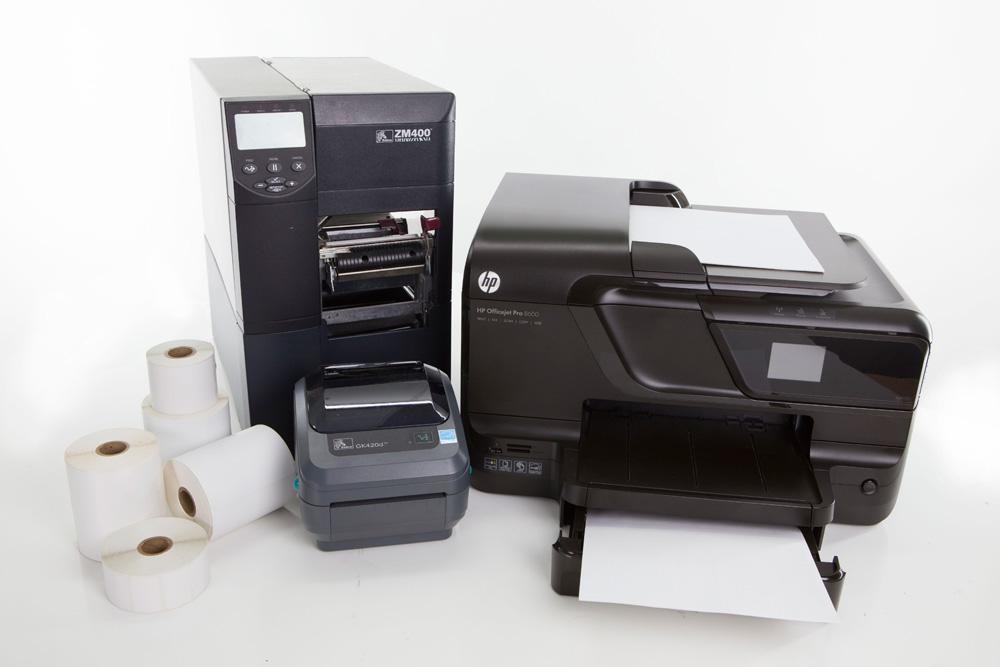Sheet Labels vs. Roll Labels: What's the Difference?

There are a million and one uses for labels: shipping labels, product labels, filing labels, name tags, and the list goes on.
With so many purposes, the label industry isn't one-size-fits-all. And yet, when you're shopping for labels, you're expected to know what you need. That's why we've written this guide – to help you see how label types differ and which ones fit your tasks and needs.
The Basics
You have two options when it comes to purchasing labels: sheet labels and roll labels. They function vastly differently and are typically used for entirely different purposes. Keep reading to learn more about each type.
Sheet Labels
Sheet labels are the label version of printer paper. They're intended for use with inkjet and laser printers. Sheet labels come in the traditional A4 sheet size, 210mm x 297mm. You load them in your printer at home or work as usual, and voilà, you have printed labels.
Do you know which printing technology you're using right now? Find out your printer type.
Shop Sheet LabelsRoll Labels
Roll labels are labels in a rolled format. They can only be printed on using dedicated label printers (direct thermal printers, thermal transfer printers, or inkjet roll printers). The labels are spun around a cardboard spool and mounted inside the roll printer. When it's time to print, the machine feeds the label through and your printed labels come out one-by-one.
Roll labels for direct thermal and thermal transfer printers are available on two core sizes: 25mm cores and 76mm cores.
Shop Roll LabelsLabel Printing Scenarios
To help you identify the best format for your labels, we've pulled out the most common situations and outlined which type of label will work best.
If each label has different content
For projects like barcodes, dispatching labels, and name tags where each label is unique, it's faster and easier to use a roll printer. Dedicated label printers print labels out one-at-a-time, so it's easy to customise the information on each label.
If you're printing the same information on each label
For things like return address labels, it may make more sense to go with label sheets. While roll printers are faster on a per-label basis, in the long run, filling a sheet with the duplicated design and printing as many sheets as you need may take up less of your time.
If you want to print in full colour
For full colour designs, the majority of the time you'll want to go with sheets. Inkjet and laser printers are ideal for incorporating colour logos, images, and/or photographs.
The exception to the rule is if you own an inkjet roll printer. Inkjet roll printers are different from the other roll printers out there which typically only print in black and white. These are capable of printing 16.7 million colours.
If colour isn't as crucial
Go with rolls. Direct thermal and thermal transfer printers only print in black and white, so you'll save money on the ink and toner they don't use. They're also highly resistant to smudging and smearing since there's no wet ink involved.
Thermal transfer printers do have the ability to print in colour with the addition of a coloured ribbon. However, you can only print in the colour of that ribbon.
If you want a variety of shapes and sizes
Online Labels is proud to offer a variety of shapes and sizes across all label formats. The uniqueness of your shape may make the decision for you. Sheet labels typically offer more fun and creative shapes whereas roll labels tend to stick to rectangles and circles.
If you want it to last longer
Thermal transfer printers are recommended for this scenario. Because they work by melting a ribbon onto the label surface, their byproducts aren't affected by light or heat (unlike direct thermal labels). They can even withstand contact with chemicals. Common applications for lifelong labels are product identification, inventory, and asset labelling.
If you want a variety of materials and colours
We stock more than 35 sheet label materials, whereas roll label materials are not as extensive.
From waterproof labels to neon colours and glossy finishes, you can definitely let your imagination run wild with sheets.
If speed is a necessity
Roll printers eliminate the time-consuming element of printing labels. Roll printers can print a large number of labels in a short amount of time, some as high as 70 labels per minute.
If you don't want to spend a ton of money on ink
As we mentioned earlier, dedicated label printers don't rely on ink to produce their labels, so they're definitely the way to go here.
Printer cartridge ink (used exclusively by inkjet printers) is one of the most expensive liquids in the world. Toner, on the other hand, is less expensive but still a burden for laser printer users.
You'll certainly experience some cost savings with laser over inkjet, but not quite as much as you would with roll printers.
If you are printing in bulk
The cost-per-label is significantly lower with roll printers and they're substantially faster at the actual printing process.
If you're printing a couple at a time
This could go either way. We offer the multi-design tool in Maestro Label Designer to help with printing partial sheets.
But with roll labels which already function as on-demand printers, there's no extra set-up needed to print a small batch.
If you use labels for shipping
Our sheet and rolls labels are both perfect for printing shipping labels. We offer several shapes and sizes to fit with a variety of different shipping applications.
If you're short on space
Roll label printers are much more compact than traditional home and office printers. They probably can't replace all the printing you do, but they will definitely carry their own weight.
If appearance is everything
Sheet labels are a great option to add a professional look to your packages. The ability to print them in full colour and on a variety of materials can really add a touch of class to your packaging.
If you want to be cost-effective
Roll labels are generally cheaper. The more you use them, the more this value is seen. After a while, your investment in one will have paid for itself. In fact, roll labels are one of the best options for streamlining high-volume printing.
If you have a label applicator machine or want to invest in one
Is your business selling enough merchandise to warrant a label applicator? High-quantity labelling machines rely on rolls for quick and easy application. However, if you're using a small-scale application system, like those for CD labels, either option will work.
If quality control and consistency are important
When your printer starts to run low on ink, you may be able to tell in the printed results. You can avoid this issue with direct thermal and thermal transfer roll printers. They print one label at a time with resources that don't diminish.
Next Steps
After reading the information above, we hope you have a better understanding of sheet labels vs. roll labels. When you're ready, use the buttons below to shop the best labels for your project.
Shop Sheet Labels Shop Roll LabelsRegardless of your label needs, business size, or printer type, Online Labels can provide you with the perfect sheet or roll labels for your unique application. Feel free to call our award-winning customer service team at 0203 051 9664 for one-on-one support.
Once you've got the label part figured out, make sure the design lives up to your vision. Use Maestro Label Designer to create designs unique to your label specifications.


